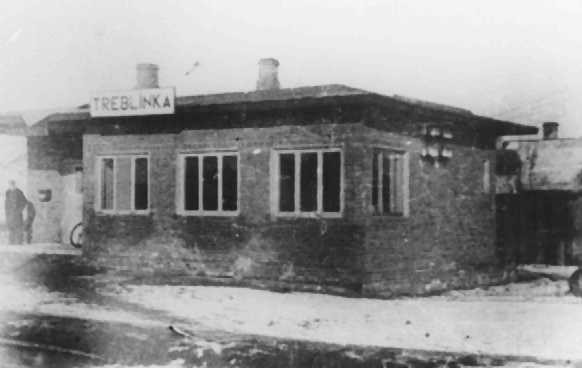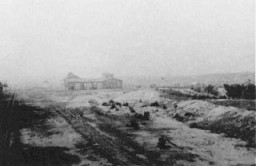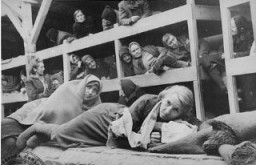
Treblinka
To carry out the mass murder of Europe's Jews, the SS established killing centers devoted exclusively or primarily to the destruction of human beings in gas chambers. Treblinka was among these killing centers. It was one of three killing centers linked to Operation Reinhard, the SS plan to murder almost two million Jews living in the German-administered territory of occupied Poland, called the General Government.
-
1
In November 1941, SS and German police authorities in the General Government established a forced-labor camp for Jews, known as Treblinka (later referred to as Treblinka I).
-
2
The killing center, referred to as Treblinka II, was constructed in the summer of 1942. It was the third killing center, after Belzec and Sobibor, established by Operation Reinhard authorities.
-
3
By the time the Treblinka killing center was dismantled in the fall of 1943, the camp personnel had murdered an estimated 925,000 Jews, as well as an unknown number of Poles, Roma, and Soviet POWs.
Treblinka became one of three killing centers created as part of Operation Reinhard (also known as Aktion Reinhard or Einsatz Reinhard). It was first established as a forced-labor camp.
In November 1941, under the auspices of the SS and Police Leader for the Warsaw District in the General Government, SS and police authorities established a forced-labor camp for Jews, known as Treblinka. This camp was later referred to as Treblinka I. It also served the SS and police authorities as a labor education camp for non-Jewish Poles whom the Germans perceived to have violated labor discipline. Both Polish and Jewish inmates, imprisoned in separate compounds, were deployed as forced labor. The majority of the forced laborers worked in a nearby gravel pit.
In July 1942, the authorities of Operation Reinhard completed the construction of a killing center, referred to as Treblinka II. Treblinka II was intended for the extermination of Warsaw's Jews and located in the Warsaw District of the General Government. However, because it was part of Operation Reinhard, it was administered by Odilo Globocnik. Globocnik was the SS and Police Leader of the Lublin District.
When Treblinka II commenced operations, the two other Operation Reinhard killing centers, were already in operation. These killing centers were Belzec and Sobibor.
The Location and Topography of Treblinka II
Treblinka labor camp and killing center were established during the German occupation of Poland in World War II. They were located in the Warsaw District of the General Government (Generalgouvernement).
The labor camp was known as Treblinka I. It was constructed around a gravel pit that had been worked before the war and was located about 3.5 miles from the Treblinka village railway station. While this was a sparsely populated area, it was in close proximity to an important railway junction in a larger village called Malkinia Gorna. The Malkinia Gorna railway junction was located about mid-way on the approximately 100-mile rail line between Warsaw and Bialystok. Its location provided good rail connections between districts of the General Government and the cities of Warsaw, Lublin, Radom, and Bialystok.
Operation Reinhard authorities chose the site for the Treblinka killing center in this remote area. Treblinka II was opened approximately a mile south of the labor camp. It was located near the village of Wolka Okraglik along another railway line, the Malkinia-Siedlce connection. The Germans improved the rail connections between these various points by building a rail spur that led from the labor camp to the killing center and that also connected to the Malkinia station.
The site of the killing center was heavily wooded and hidden from view. It was laid out in a trapezoid covering an area of 1,312 by 1,968 feet (an area equivalent to almost 34 soccer fields). Pine branches woven into the eight-foot tall barbed-wire fence and trees planted around the perimeter served as camouflage, blocking any view into the camp from the outside. Watchtowers 26 feet high (almost 2.5 stories) were placed along the fence and at each of the four corners.
The killing center was divided into three parts: the reception area, the living area, and the killing area. The living area contained housing for German staff and the guard unit. It also contained administrative offices, a clinic, storerooms, and workshops. One section contained barracks that housed those Jewish prisoners selected from incoming transports to provide forced labor. This forced labor was intended to support the camp’s function: mass murder.
Deportations to Treblinka
Deportations to Treblinka came mainly from the ghettos of the Warsaw and Radom districts in the General Government. Between late July and September 1942, the Germans deported around 265,000 Jews from the Warsaw ghetto to Treblinka. Between August and November 1942, SS and police authorities deported around 346,000 Jews to Treblinka II from the Radom District. From October 1942 until February 1943, the Germans deported to the Treblinka killing center more than 110,000 Jews from the Bialystok District, a section of German-occupied Poland that was attached administratively to German East Prussia. Treblinka also received transports of at least 33,300 Jews from the Lublin District.
German SS and police authorities deported Jews to Treblinka from the Bulgarian-occupied zones in Thrace and Macedonia. They also deported some 8,000 Jews from Theresienstadt in the Protectorate of Bohemia and Moravia. Other small groups of Jews of undetermined numbers were killed at Treblinka II. The Germans deported these groups from Germany, Austria, France, and Slovakia via various transit locations in the General Government. In addition, an undetermined number of Roma (Gypsies) and Poles were killed at Treblinka II.
Deportations to Treblinka continued until the spring of 1943. Most prominent among the deportations were the approximately 7,000 Jews transported from the Warsaw ghetto after its liquidation following the Warsaw ghetto uprising. A few isolated transports arrived after May 1943.
The Staff of Treblinka I and II
The authorities at the killing center, Treblinka II, consisted of a staff of between 25 and 35 German SS and police officials. As with the other Operation Reinhard killing centers, the majority of German camp officials belonged to the T4 (“euthanasia”) organization.
The first commandant of Treblinka II was Dr. Irmfried Eberl, a physician. Eberl had gassed patients as medical director of the Brandenburg and Bernburg “euthanasia” facilities. However, his poor management of Treblinka led to his dismissal on August 26, 1942, just six weeks after he arrived. His replacement, SS Captain Franz Stangl, was transferred from the Sobibor killing center. Stangl was a former policeman in the Criminal Police (Kripo). He had previously served as deputy office manager at the Hartheim and Bernburg “euthanasia” killing centers. On August 23, 1943, following the prisoner revolt at Treblinka, Kurt Franz succeeded Stangl as commandant. Franz was previously a cook at the Hartheim, Brandenburg, Grafeneck, and Sonnenstein “euthanasia” centers, as well as at the Belzec killing center. He remained commandant at Treblinka II until its liquidation in November 1943.
SS Captain Theodor van Eupen was the commandant of Treblinka I, the labor camp, from 1941 through 1944. Unlike Treblinka II, which was part of Operation Reinhard, the commandant of Treblinka I did not report to the Operation Reinhard and T4 authorities. Rather, Treblinka I’s commandant was subordinate to the SS and Police Leader in Warsaw. Under the leadership of German authorities stood a police auxiliary guard unit of between 90 and 150 men. All of these men were either former Soviet prisoners of war (POWs) of various nationalities or Ukrainian civilians selected or recruited for this purpose. Members of the guard unit were trained at a special facility of the SS and Police Leader in Lublin, the Trawniki training camp.
Mass Murder
Incoming trains of about 50 or 60 cars bound for the killing center first stopped at the Malkinia railway station. Twenty cars at a time were detached from the train and brought into the killing center. The guards ordered the victims to disembark in the reception area, which contained the railway siding and platform. One building erected on the platform was disguised as a small railway station, complete with a wooden clock and fictive rail terminal signs and railway schedules.
German SS and police personnel announced that the deportees had arrived at a transit camp. Deportees were required to hand over all valuables. The reception area contained a fenced-in "deportation square" with two barracks in which deportees—with men separated from women and children—had to undress. It also contained large storerooms. This is where the possessions relinquished by victims were sorted and stored. Next, the goods were shipped to Germany via Lublin.
A camouflaged, fenced-in path led from the reception area to the gas chamber entrance, located in the killing area. This was known as the “tube” [“Schlauch”]. Victims were forced to run naked along this path to the gas chambers, deceptively labeled as showers. Once the chamber doors were sealed, a large diesel engine installed outside the building pumped in carbon monoxide exhaust. All those inside were killed.
Sonderkommando at Treblinka II
The Sonderkommando (special detachment) was a group of Jewish prisoners selected to remain alive as forced laborers. Members of this group worked in the killing area. They removed bodies from the gas chambers and initially buried them in mass graves. In October 1942, camp personnel deployed Jewish forced laborers to exhume these mass graves. The forced laborers were ordered to burn the bodies on open-air “ovens” made from rail track. This was in keeping with the efforts of the Sonderkommando 1005, tasked with excavating and destroying evidence of Nazi mass murder in the German-occupied east. German personnel and the Trawniki-trained auxiliaries periodically murdered the members of detachments of Jewish laborers and replaced them with persons from newly arriving transports.
Sonderkommando prisoners selected as forced laborers worked in the administration-reception area of the camp. They were tasked with forcing the new arrivals to detrain, disrobe, and relinquish their valuables. They were also forced to drive their fellow Jews into the “tube” which led to the gas chambers. Prisoners then sorted the victims’ possessions in preparation for transport to Germany. In addition, they cleaned out freight cars for the next deportation. Victims who were too weak or ill to reach the gas chambers on their own were told they would receive medical attention. Members of the Sonderkommando carried them to a camouflaged area, which was disguised as a small clinic using a Red Cross flag. There, SS Corporal Willi Mentz shot the victims in an open pit. Previously, Mentz had performed agricultural work at the Grafeneck and Hadamar “euthanasia” facilities.
Resistance and Revolt in Treblinka
Jewish inmates organized a resistance group in early 1943. When camp operations neared completion, the prisoners feared they would be killed and the camp dismantled. During the late spring and summer of 1943, the resistance leaders decided to revolt. On August 2, 1943, prisoners quietly seized weapons from the camp armory. However, they were discovered before they could take over the camp. Hundreds of prisoners stormed the main gate in an attempt to escape. Many were killed by machine-gun fire. More than 300 did escape—though two-thirds of them were eventually tracked down and killed by German SS and police, as well as by military units. Surviving prisoners were forced to dismantle the camp. They were supervised by German SS and police personnel, who were acting upon orders from Odilo Globocnik. After completion of this job, the German SS and police authorities shot the prisoners.
The End of the Treblinka Camps
German officials ordered that Treblinka II be dismantled in the fall of 1943.
From late July 1942 through September 1943, the camp personnel murdered an estimated 925,000 Jews at the Treblinka killing center. They also killed an unknown number of Poles, Roma, and Soviet POWs. Treblinka I, the forced-labor camp, operated until late July 1944. While the killing center was in operation, some of the arriving Jews were selected and transferred to Treblinka I. Those Jews too weak to work at Treblinka I were periodically sent to Treblinka II to be killed.
During late July 1944, with Soviet troops moving into the area, camp authorities and Trawniki guards shot the 300-700 remaining Jewish prisoners. The camp was hastily dismantled and evacuated. All traces of it were destroyed. Lupine flowers were sown on the grounds, and an ethnic German farmer was installed on the property to camouflage the reality of what had occurred at this site.
Soviet Red Army troops overran the site of both labor camp and killing center during the last week of July 1944.
Critical Thinking Questions
- Where were the killing centers located? To what degree was the local population aware of the camps, their purpose, and the conditions within? How would you begin to research this question?
- Did the outside world have any knowledge about the killing centers? If so, what actions were taken by other countries and their officials?
- What choices do other countries have in the face of mistreatment of civilians?
Further Reading
Arad, Yitzhak. Belzec, Sobibor, Treblinka: The Operation Reinhard Death Camps (Bloomington, IN: Indiana University Press, 1987).
Glazar, Richard. Trap with a Green Fence: Survival in Treblinka, trans. Roslyn Theobald (Evanston, IL: Northwestern University Press, 1995).
Sereny, Gitta. Into that Darkness: An Examination of Conscience (New York: Vintage Books, 1983).







